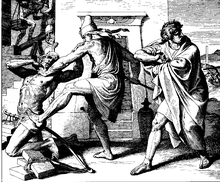FAIR and interactive data graphics from a scientific knowledge graph
Contents
Voluntary manslaughter is the killing of a human in which the offender acted in the heat of passion, a state that would cause a reasonable person to become emotionally or mentally disturbed to the point that they cannot reasonably control their emotions. Voluntary manslaughter is one of two main types of manslaughter, the other being involuntary manslaughter.
Provocation

Provocation consists of the reasons for which one person kills another. "Adequate" or "reasonable" provocation is what makes the difference between voluntary manslaughter and murder. Provocation is said to be adequate if it would cause a reasonable person to lose self-control.[1]
State of mind
Intent to kill
Voluntary manslaughter requires the same intent as murder. The charge of murder is reduced to manslaughter when the defendant's culpability for the crime is "negated" or mitigated by adequate provocation.[2]
Imperfect self-defense
In some jurisdictions, malice can also be negated by imperfect self-defense, the principle that an honest but unreasonable belief that it is necessary to defend oneself from imminent peril to life or great bodily injury negates malice aforethought, the mental element necessary for a murder charge, so that the chargeable offense is reduced to manslaughter.[3] Self-defense is considered imperfect when extenuating circumstances exist that are insufficient to constitute a complete legal defense to homicide, but nonetheless partially excuse the act that resulted in death.
United States
Model Penal Code
The United States' Model Penal Code (MPC) does not use the common law language of voluntary and involuntary manslaughter. Under the MPC, a homicide that would otherwise be murder is reduced to manslaughter when committed "under the influence of extreme mental or emotional disturbance for which there is a reasonable explanation or excuse".[4][5] Several court decisions in various jurisdictions have interpreted this language broadly by creating a subjective standard to determine whether the provocation was adequate from the defendant's point of view. This subjective standard diverges substantially from the common law reasonable person test and allows the jury greater latitude.[6]
For example, in State v. Dumlao, the court interpreted the MPC language broadly, holding that reasonableness should be evaluated from the defendant's perspective. The subjective standard for whether a provocation was reasonable, and thus adequate, would allow a jury to consider Dumlao's "mental abnormalities", including a medical diagnosis of "paranoid personality disorder".[7]
Case law
| Case name | Year | Citation | State | Doctrine | Court's decision |
|---|---|---|---|---|---|
| People v. Valentine | 1946 | 28 Cal.2d 121 | CA | Heat of passion; mere words | Resolved a century long split in California courts, holding that mere words could be adequate provocation |
| People v. Berry | 1976 | 18 Cal.3d 509 | CA | Heat of passion | Taunting or provocation over a prolonged period can be adequate provocation |
| State v. Dumlao | 1986 | 715 P.2d 822 | HI | Extreme emotional disturbance | Under the MPC, the reasonable person test for adequate provocation uses a subjective standard to be evaluated from defendant's viewpoint |
| People v. Chevalier | 1989 | 544 N.E.2d 942 | IL | Mere words | Verbal admission of infidelity is not adequate provocation |
| State v. Shane | 1993 | 590 N.E.2d 272 | OH | Mere words | Verbal admission of infidelity is not adequate provocation |
References
- ^ Smalleger, Frank; Hall, Daniel (2015). Criminal Law Today (5 ed.). Upper Saddle River, New Jersey: Pearson Education, Inc. ISBN 978-0133008586. Retrieved 9 September 2017.
- ^ Scott Mire and Cliff Roberson, The Study of Violent Crime: Its Correlates and Concerns (Boca Raton, FL: CRC Press, 2011), 138
- ^ Grossman, Jonathan. "Defense Theories and Instructions" (PDF). Sixth District Appellate Program. Retrieved 9 September 2017.
- ^ See Model Penal Code § 210.3
- ^ Dubber, Markus D. (2015-03-10). An Introduction to the Model Penal Code. Oxford University Press. ISBN 978-0-19-024307-4.
- ^ David C. Brody, James R. Acker & Wayne A. Logan, Criminal Law 353 (2001).
- ^ Farahany, Nita (2011-02-20). The Impact of Behavioral Sciences on Criminal Law. Oxford University Press. ISBN 978-0-19-977330-5.

















